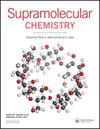咪唑包合物中宿主辅助的分子间质子转移;对磺托环[4]芳烃
IF 2.6
4区 化学
Q3 CHEMISTRY, MULTIDISCIPLINARY
引用次数: 0
摘要
摘要:本文报道了以对磺酰基羧基芳烃五阴离子为宿主分子,以1-甲基咪唑或1-丁基咪唑单位为客体,水化钆(III)离子和四苯基磷离子为络合物的结构分析。在这些包合物的形成过程中,发现了一个有趣的过程,其中质子通过酸碱反应从对磺酰基[4]芳烃转移到中性客体分子。1H NMR实验证实了溶液中杯芳烃与咪唑类化合物之间的质子转移和主客体配合物的形成。在CrystalExplorer的辅助下进行仔细分析,很容易识别出有助于主-客体复合物形成稳定的主要分子间相互作用。无论客体物质的类型如何,两种复合物的扩展结构中普遍存在双层排列。图形抽象本文章由计算机程序翻译,如有差异,请以英文原文为准。
Host-aided intermolecular proton transfer in the inclusion complexes of imidazole ⊂ p-sulfonatocalix[4]arene
ABSTRACT Structural analysis of two multi-component complexes comprising p-sulfonatocalix[4]arene penta-anion as the host molecule and 1-methylimidazolium or 1-butylimidazolium monocation as the guest species, aquated gadolinium(III) ion along with tetraphenylphosphonium cation, is reported. An interesting process during the formation of these inclusion complexes was seen, in which a proton transfer from p-sulfonatocalix[4]arene to the neutral guest molecules took place via acid-base reaction. 1H NMR experiment confirms the formation of the host–guest complexes and the proton transfer between the calixarene and imidazolium species in solution. Careful analysis aided by CrystalExplorer, the dominant intermolecular interactions that contribute to the stabilisation of the host–guest complex formation were readily identified. Bilayer arrangement prevails in the extended structure for both complexes regardless of the type of guest species. Graphical Abstract
求助全文
通过发布文献求助,成功后即可免费获取论文全文。
去求助
来源期刊

Supramolecular Chemistry
化学-化学综合
CiteScore
3.60
自引率
3.00%
发文量
5
审稿时长
2.7 months
期刊介绍:
Supramolecular Chemistry welcomes manuscripts from the fields and sub-disciplines related to supramolecular chemistry and non-covalent interactions. From host-guest chemistry, self-assembly and systems chemistry, through materials chemistry and biochemical systems, we interpret supramolecular chemistry in the broadest possible sense. Interdisciplinary manuscripts are particularly encouraged. Manuscript types include: high priority communications; full papers; reviews, and; Methods papers, techniques tutorials highlighting procedures and technologies that are important to the field. We aim to publish papers in a timely fashion and as soon as a paper has been accepted and typeset it will be published in electronic form on the Latest articles section of the website. The two most important review criteria are that the paper presents high-quality work that fits generally into the broad spectrum of activities in the supramolecular chemistry field. Under normal circumstances, Supramolecular Chemistry does not consider manuscripts that would be more suitable in a highly specialized journal. This includes, but is not limited to, those based mostly or exclusively on topics such as solid state/X-ray structures, computational chemistry, or electrochemistry. .
The two most important review criteria are that the paper presents high-quality work that fits generally into the broad spectrum of activities in the supramolecular chemistry field.
 求助内容:
求助内容: 应助结果提醒方式:
应助结果提醒方式:


